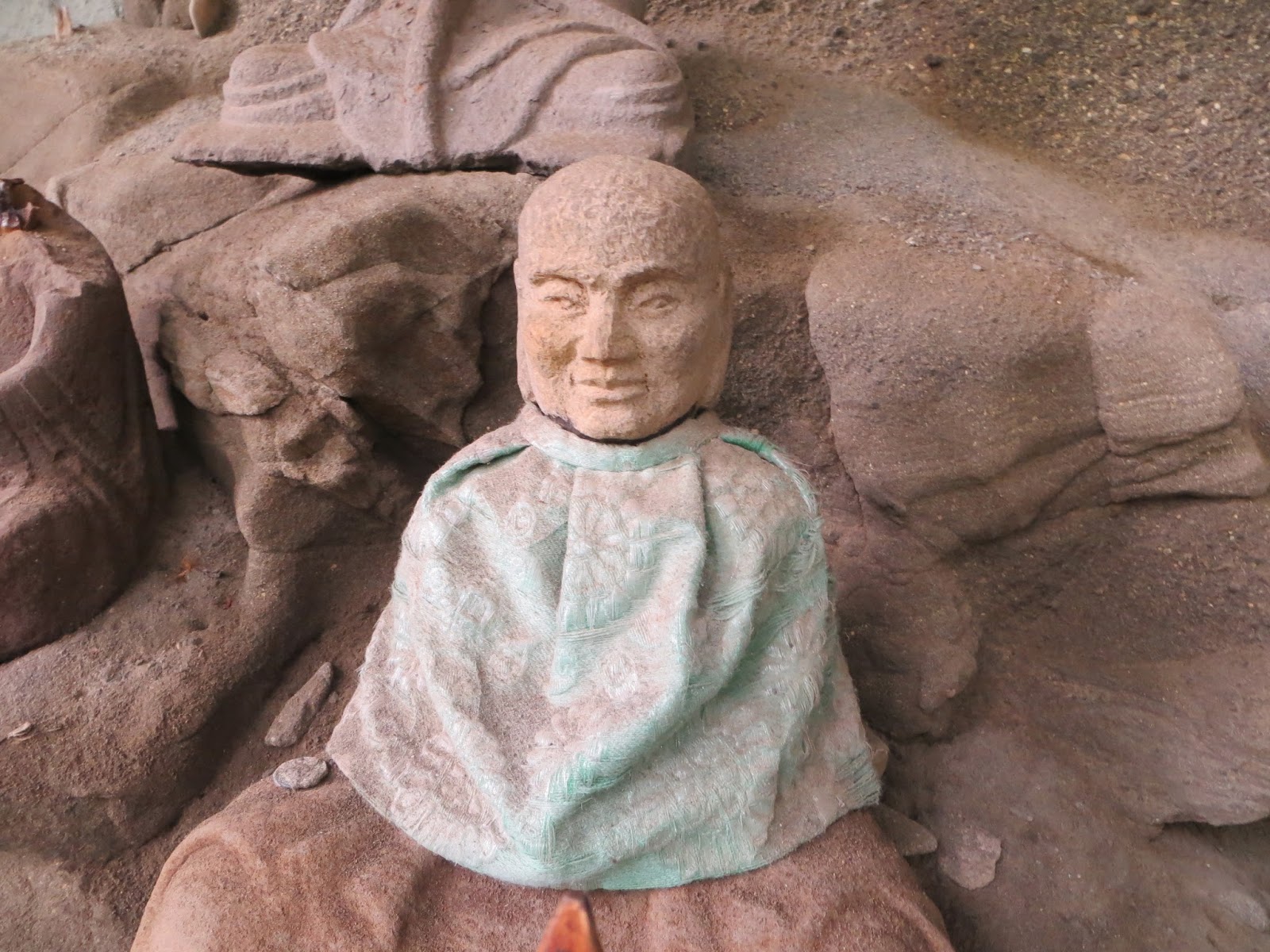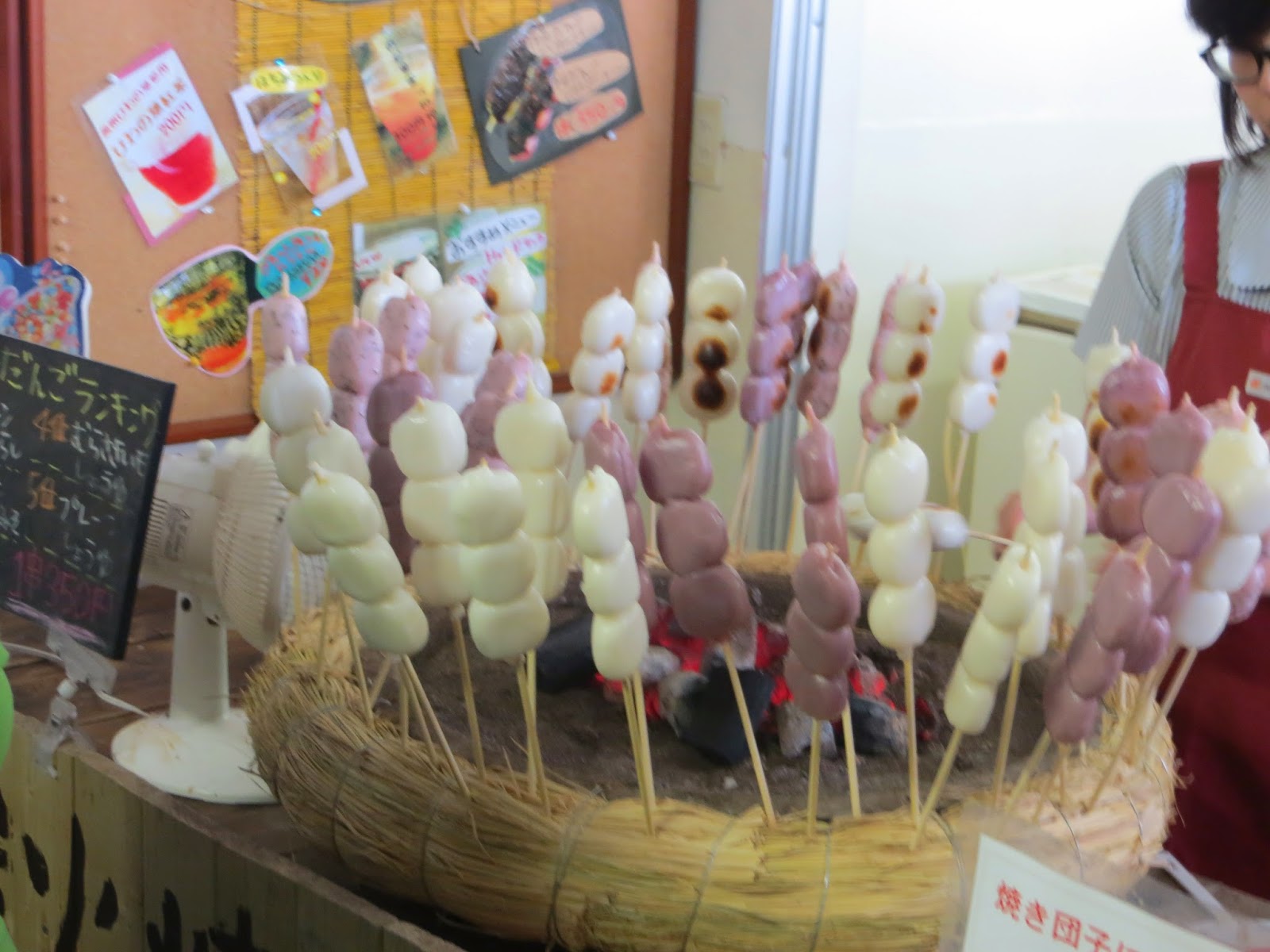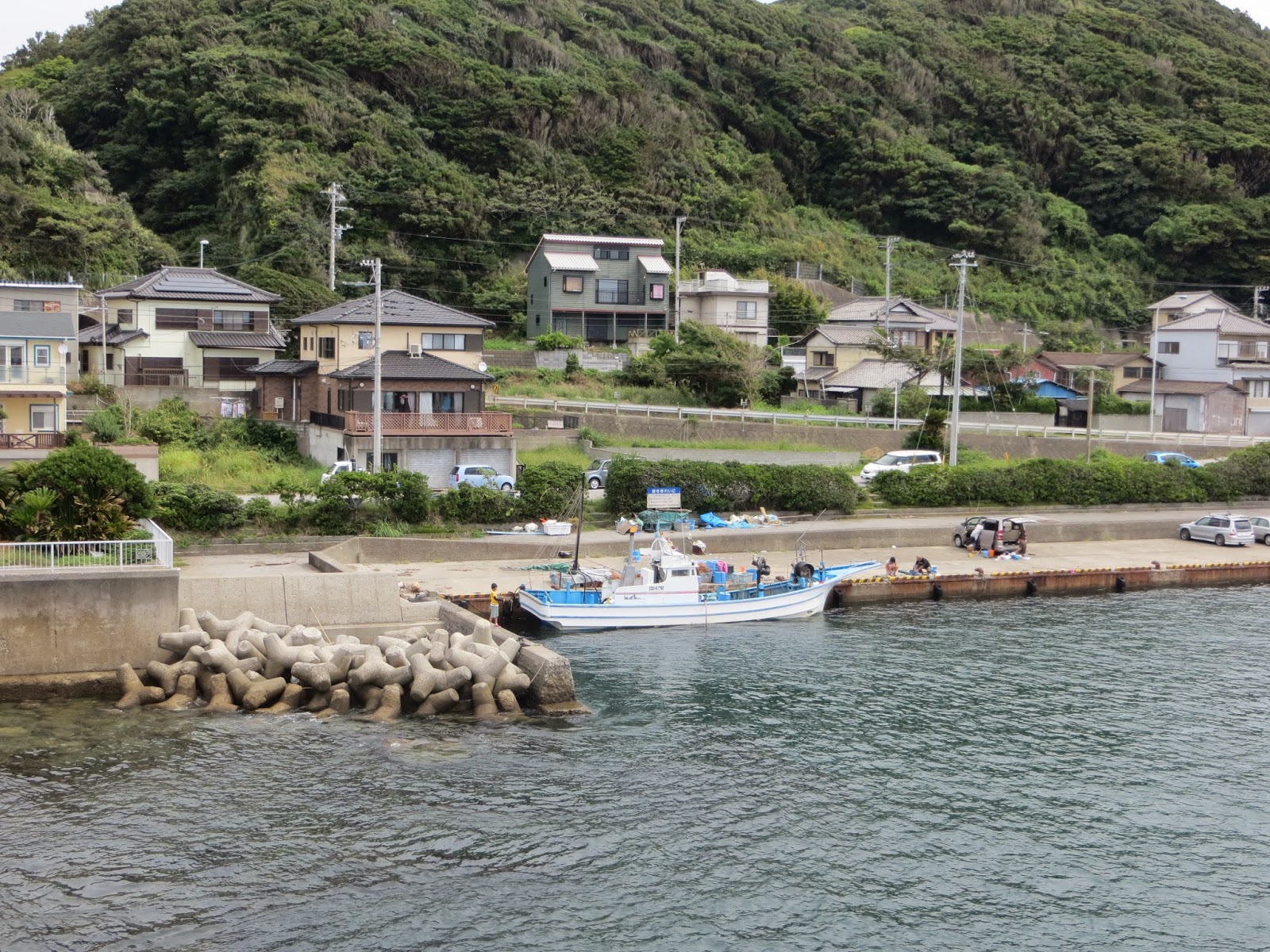 |
Hi Everybody,
Yes, of course, we have been off on another adventure. It was "Respect for the Aged Day" on Monday, so we "aged" decided to go to Nokogiriyama. Pictured above is the ferry that we took after taking two train rides on our way to Nokogiri-yama or "saw mountain" which is what Nokogiriyama means in Japanese. The mountains (yama) are supposed to look like the teeth on the blade of a saw. The mountain was a stone cutting quarry in the Edo era and the Boshu-stone from here was shipped to Tokyo, which at that time was called "Edo". The stone was then used to build navy ports and fortresses, buildings and shrines and the Waseda University. The stone cutting ended in the 1970's, and since then Nokogiri-yama has become a tourist spot. |
 |
| Leave it to Elder Chandler to notice the cooling tower stacks on this power plant. Also, notice the unusual framework around the towers to protect them from being blown over in typhoons. |
 |
| Here's a big freighter |
 |
| You can see the tram or the "ropeway" as it is called that we took to go up the mountain. |
 |
| We always like to see palm trees as there aren't too many around, and you can see the mountains which have a jagged profile because the mountain was quarried during the Edo Period and, as stated before, the stone was used for Tokyo, or Edo, as Tokyo was called at that time. Tokyo was built on marshy land so they had to use large amounts of solid stone to build the firm foundations for the buildings and Nokogiriyama was the most convenient source even though it isn't so convenient to Tokyo. |
 |
| When we got to the town of Kanaya we took a little bus ride to get us closer to the mountain. |
 |
| Then we walked a mile or so or maybe it was a half a mile (who knows?) to get to the tram. |
 |
| Here's Elder Chandler getting on the ropeway or cable car which took us to the top in five minutes. The cable car travels 680 meters which is about a half a mile. |
 |
| At the top there is a beautiful view of the Boso hills and Tokyo Bay. |
 |
Here's our group of senior missionaries for the Asia North Area office: the Grahams (Area Mental Health Advisor), the Hansens (Area Medical Advisor), the Woods (Public Affairs Missionaries) Chandlers (Area Executive Secretary), and the Ricks (Area Associate Legal Council) and it is pretty unusual to get us all together to go somewhere. They all work really hard and are very dedicated missionaries. They were receiving phone calls and solving problems all day long even on our 'day off'. Missionaries receive no money for serving
They are all willing to sacrifice their time and money and pay for all the expense that it cost to be here. The pay we receive is satisfaction in knowing that we are doing what the Lord would have us do and the "pay" is the "heavenly blessings" that we receive.
|
 |
| There were steps and more steps to get to the different places on the mountain. The steps were very uneven and not for those with weak ankles! |
I
t was all worth it, though, when we arrived at the "Hundred-shaku Kannon" which is a tall relief image of Kannon carved into a quarry wall. I read that it was carved as a memorial and prayer for victims of war.
 |
| Officially, it is named the goddess, Kannon Bosatsu, 30.3 meters high, carved with sharp lines into the vertical cliff. |
|
If you have time, here’s something from
the Japan Times about Kannon, otherwise
just scroll on:)
Kannon: The Goddess of Mercy and Pets
Today I’d like to introduce you to
someone so important, she may change your life. She has been a highly revered
VIP for years, and is a household name in Japan, China and India. Although she
is relatively unknown to the Western world, her accolades abound. She is
Kannon, the goddess of mercy. I’d like to introduce you to her because she has
some real estate I think you might be interested in.
If you live in Japan, you’ve seen
Kannon many, many times. You may not have even realized who she was. Just in
case you’re interested, I’d like to offer a formal introduction.
Kannon presides over her Pure Land
in the South called Fudaraku, an island-mountain paradise. You can catch a
glimpse of this magnificent place in paintings that depict the goddess
descending the mountain to welcome those who seek her salvation. She is also
prominent in sculpture, and her icons grace Buddhist temples all over Japan.
Many of these icons have been designated national treasures.
Kannon is a Bodhisattva, which means
she has prolonged her own eternal enlightenment to stay behind and help everyone
who suffers in this world. Now that’s compassion!
Twenty-nine of the temples on the
Shikoku 88 Temple Pilgrimage are dedicated to Kannon. Here are just a few of
the legends surrounding them:
Temple No. 10, Kirihataji, is famous
for the story of a beautiful young woman who wove cloth for the priest Kobo
Daishi during his seven-day ascetic practice there. Upon completion, the woman
told him of her loyalty to Kannon and the Daishi carved a statue of Kannon,
“bowing three times before each cut of the blade into the sacred wood.” When he
finished, the girl asked the Daishi to ordain her a Buddhist nun, and as he
did, she was transformed into Kannon herself.
At temple No. 27, Konomineji, the
image of Kannon is hibutsu, meaning it is so sacred it cannot be shown to
the public.
At the southern tip of Shikoku on
Cape Ashizuri, temple No. 38, Kongofukuji, sits on a cliff. Kannon worshippers
would set out in boats from this coast, never to be heard from again. They left
in pursuit of Kannon’s Pure Land of Fudaraku.
In the 6th century a man from
Kyushu, named Mano, was saved by Kannon from a shipwreck while en route to
Osaka. He thanked Kannon for her supreme intervention by building temple No.
52, Taisanji, for her.
Kannon is also the symbol of the
divine mother. At temple No. 62, Hojuji, a Lord Ouchi’s wife prayed to Kannon
for an easy childbirth. When her wish was granted, she returned the favor by
writing a goeika chant in Kannon’s honor, which remains a part of this
temple.
The goddess of mercy even has entire
pilgrimages dedicated to her, the most famous being the Saikoku Kannon
Pilgrimage in Kansai. Kannon pilgrimages have 33 sites of worship, symbolizing
the goddess’s 33 different appearances she can take on to save people.
Followers who visit 100 sites on combined Kannon pilgrimages can gain
everlasting life. Even the founder of Zen Buddhism, Daruma (of Daruma doll
fame) is considered to be an incarnation of Kannon.
Here are a few of the more popular
images of Kannon which can be seen around Japan.
Senju Kannon (Kannon of a thousand arms) is the most popular of all
images. She holds 1,000 implements including an arrow, spear, bell, mirror and
a moon to help save you. With so many tools at her disposal (probably even cell
phones and cameras these days) it is no wonder it is said that Kannon “sees all
and hears all.”
Juichimen Kannon (Kannon with 11 faces)
In this manifestation, the goddess
carries juzu prayer beads, a lotus flower and a weapon. She forms the
mudra with her hands that means “fearless.” She offers recovery from sickness,
rescue from poison and protection from fires, among other things. Her
worshippers enjoy the protection of Buddha.
Sho Kannon
The most distinguished of the Kannon
Bodhisattvas holds an unopened lotus in one hand, which represents the Buddha
nature in us all, waiting to flower. Her other hand is open ready to rescue her
followers.
(I think this is the Kannon pictured above as it looked like a flower in her hand, we thought)
Bato Kannon (Horse-headed Kannon)
Traditional affinity with warriors
and samurai, those who worship Bato Kannon are protected from calamities,
sickness and accidental death. This Kannon is depicted as having the head of a
horse, and is seated on a lotus petal, holding fighting implements. These days
Bato Kannon is popular among soldiers, seafarers and construction workers.
Farmers have also been known to pray to Bato Kannon for the health of their
horses and cows.
As deities often do, Kannon has
adapted to modern wishes and desires by recently manifesting herself in yet
another form, that of Dobutsu Shugo Kannon. While Kannon is known to protect
animals, it now appears she is expanding her compassion to cats, dogs and other
pets. I do hope pets are also granted eternal salvation in Kannon’s Pure Land
real estate in the South.
But even after your pet dies and
goes off to Fudaraku to await your arrival, there is still plenty you can do
for your pet. Visiting the sacred sites of the Shikoku 88 Temple Pilgrimage to
pray for recently deceased relatives has a long tradition in Japan called kuyo.
It is believed that praying on such a pilgrimage helps the deceased’s soul rest
easier. You can now do this for your pet too. It’s called, naturally, petto
kuyo.
Now I have formally introduced you
to the compassionate Kannon, goddess of mercy.
 |
| There were some pretty spectacular viewing areas, too. |
 |
| Fortunately, there were also lots of even steps, too, but remember we still had to climb back up when we would walk down and it seemed like never-ending steps. |
 |
| There are 1,500 little Rakan statues displayed in many different places around the mountain. They are supposed to be disciples of Buddha whose faces are supposed to convey benevolence and accompany you. (I'm not so sure what the accompany you is all about, though.) All
were carved by the master craftsman, Jingoro Eirei Ono, and his 27
monks between 1779 and 1798. But it was sad to see that many of the statues without heads as they were beheaded by an anti-Buddhist
movement during the Meiji era. |
 |
| "I've got a headache- this big!" |
 |
| I think the ones at the bottom are telling jokes to each other! |
 |
| When the Whiting's visited, they said they saw monkeys in the forest but, unfortunately, we didn't. |
 |
| I don't know why but this head is my favorite. |
 |
| Someone had added a bib to this one but it looks like that was done a long time ago. There were also quite a few spiders and spider webs. |
 |
Actually, I read that there are 2,639 steps, but I think there are more than that!
|
 |
| Notice all the tree roots on the pathway. |
 |
| We finally arrived at the great Budha. According to the legend, this Budha statue carved in the rock (between 1780 and 1783) represents “a pure place in the world of a lotus flower”, a symbol of peace and tranquility. |
The "daibutsu" which translated means "Giant Budha" is a huge seated carving of Yakushi Niyori, the Budha of healing and medicine. It is 31.05 meters (101.9 feet) tall. Counting the carving around the statue, it is 41 meters tall, and it is the largest stone-carved Daibutsu in Japan.
 |
| In front of this sculpture, it was written in Japananese kanji, "Nokogiriyama onegaishimasu" Onegai means to pray or to wish for something. One of the missionaries told me that he thought that people buy these little statues with the little coats and hats to offer some kind of prayer asking for something. There was also a giant pile of discarded sculptures with no hats or coats beside these that have their coats and hats. |
 |
| Before we got back on the tram, one of the missionaries stopped for mochi. It is quite good and it is made of pounded rice. This mochi was also roasted. |
 |
| Walking back to the little town, we passed this pretty little fountain and flowers in someone's yard. |
 |
| Happiness for some of us was getting back to a fish restaurant and having fresh sushi. |
 |
| Here's Elder Ricks ready for some serious eating. |
 |
| Elder Chandler had seafood pasta made of oysters, shrimp, calamari, and crab. |
 |
| As we traveled back on the ferry, the seagulls were going crazy trying to eat the crackers and things that people held out for them to get. I think they follow the ferry back and forth all day long. They have to fly really fast and hard to keep up. They were all pretty much exhausted flying around in circles and trying to get the food. One of the sister missionaries got a pretty good bite on her finger from the seagull but she kept feeding them anyway. Good thing her husband is the medical advisor. It was very entertaining to watch, though. |
 |
| We come to the end of a perfect day! |
|
(Except of course for the walk back to the bus, the bus ride, and two long train rides, and walk back "home".)




























































No comments:
Post a Comment